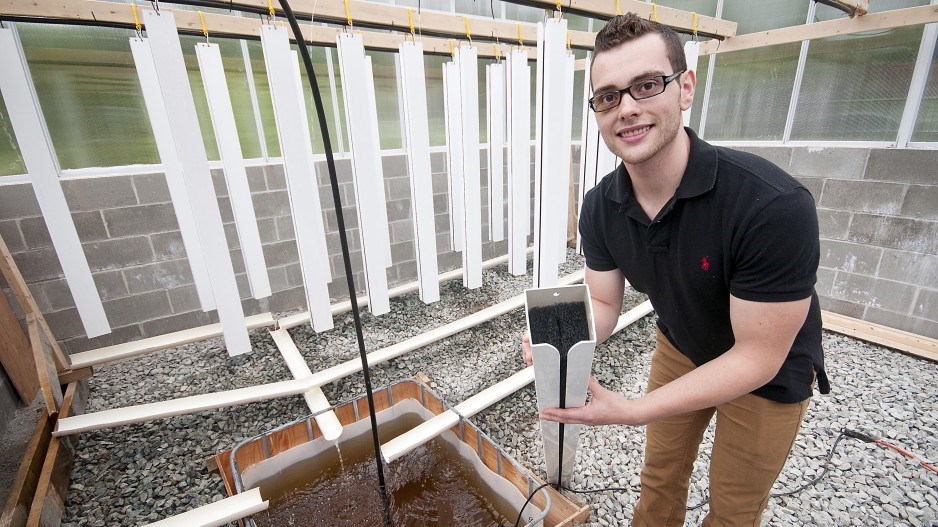BC imports more than 67% of its fruits and vegetables from the United States and more than half of that percentage comes from California.
As B.C.’s U.S. neighbours struggle through one of the worst droughts on record, reduced crop yields have put enormous pressure on B.C. food prices, driving up costs for broccoli, lettuce, strawberries and other crops that used to be locally grown but are now largely imported from south of the border.
The glaring problem turned into a light-bulb moment for Simon Fraser University’s (SFU) Sustainable Community Development Certificate program and fourth-year business student Ethan O’Brien, who was inspired by the food-supply issue to come up with an award-winning business idea. O’Brien and his Living Garden Foods Corp. startup business recently won the SFU Opportunity Fest’s Vancity Grand Prize for social, sustainable and economic innovation.
“When I found out about the inefficiencies in the food system and the coming food shortage from the California drought, I realized that we quickly need to figure out how to solve these problems in our local community,” said O’Brien, who is taking most of his courses out of SFU Surrey and also supporting himself by working part-time in Surrey for Peter F. Pook Insurance Agencies Ltd., a family-owned company.
“We cannot rely on foreign imported food for the rest of our lives because one day that source of food may dry up. Small, local, field-based farmers are a booming industry in the last decade, but they do not have the infrastructure or technology to produce food year-round, which still doesn’t solve our problem. So I decided to figure out a solution that could produce food 365 days of the year, be environmentally sustainable and dramatically reduce waste in the industry.”
The result is Living Garden Foods, in which O’Brien has combined two ideas: aquaponics, which uses fish, microbial bacteria and plants in a mini self-sustaining ecosystem, and five-foot-tall plant-growing towers. O’Brien said the towers use 90% less water and 90% less land than traditional agriculture. The system also doesn’t generate runoff from pesticides or fertilizers.
“Combining plants and fish into one system is a good way to achieve this,” he said. “In our recirculating system the plants clean the nitrates out of the fish water, which means we do not need to replace the water in the system. This direct source of natural nitrates allows our plants to grow two to three times faster than crops grown in a field with traditional fertilizing methods.”
O’Brien is finishing his first model, which will be ready for market in the coming weeks. His compact design means some gardens for produce such as herbs could literally be stationed in grocery stores.
“The market for herbs is quite big,” he added. “In our business plan, we did it based on a 3,000-square-foot greenhouse that could hold 600 growing towers. In order to sell all of our towers we would need to be in 20 grocery stores and we would make $38,400 with an 80% contribution margin ratio at wholesale prices – all strictly in theory at the moment, though.”
Living Garden Foods is part of a new breed of companies coming out of SFU’s Venture Connection startup incubator. The program has also spawned the Surrey company MetaOptima, the maker of MoleScope, which monitors for early signs of skin cancer via a handheld device attached to a mobile phone and also allows for updates to be sent to a dermatologist. Michelle Unrau-Sinclair, Venture Connection’s Surrey-based manager, said the creators of MetaOptima and Living Garden Foods are perfect examples of a new wave of topical entrepreneurs coming through the education system into the business world.
“[Living Garden] Foods is a novel and timely opportunity to serve a growing number of consumers who want to buy and eat fresh local produce,” Unrau-Sinclair said. “It’s also a more space-efficient system as well; the vertical design allows growing with a substantially reduced footprint, thus reducing space and cost.”
O’Brien said his recycling aquaponics growing system could outcompete conventional growers in Hawaii, California and Mexico by offering fresher fruits and vegetables grown locally with a drastically reduced ecological footprint.
He said his first herb model can produce an average of 1.5 kilograms of herbs 10 times a year from each tower. Traditional field agriculture is limited to one to three harvests each year depending on the plant – and California’s crop cycles have been devastated by a lack of precipitation, something not needed with Living Garden Foods as the systems can be stationed anywhere with a roof and power supply.



